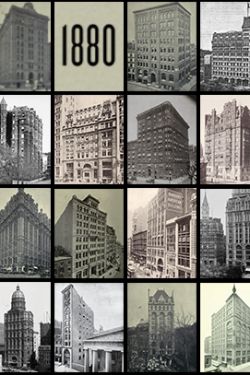In conjunction with its current exhibition TEN & TALLER, 1874-1900, The Skyscraper Museum presents a symposium that explores new narratives of the first decades of high-rise history. Organized into four sessions, on Thursday evening, March 9 and on Friday morning and afternoon, March 10, the symposium brings together a range of scholars and authors who have studied nineteenth-century New York from the perspectives of architecture, engineering, and urban history.
The first session begins with an introduction by Director Carol Willis that introduces the aims of the symposium and the evening. After her illustrated overview of key themes of the exhibition, she introduces the five speakers, who explain their research interests.
Speakers
Carol Willis is the founder, director, and curator of The Skyscraper Museum. She is the author of Form Follows Finance: Skyscrapers and Skylines in New York and Chicago (Princeton Architectural Press, 1995), among other publications. An Adjunct Associate Professor of Urban Studies at Columbia University’s GSAPP, she teaches in the program Shape of Two Cities: New York and Paris.
Donald Friedman, a structural engineer, is the president of Old Structures Engineering and author of several books, including Historical Building Construction (1995, rev. 2010). His 2014 study, “Structure in Skyscrapers: History and Preservation” was the inspiration for the exhibition,“TEN & TALLER, 1874-1900.”
Lee Gray is Professor of Architectural History in the School of Architecture at UNC Charlotte. An expert on early commercial buildings and elevator history, Lee Gray is the author of From Ascending Rooms to Express Elevators: A History of the Passenger Elevator in the 19th Century (2002). He has written monthly articles on the history of vertical transportation for Elevator World Magazine since 2003. The Tribune Building was a focus of his dissertation, “The Office Building in New York City, 1850-1880” (Ph.D. diss., Cornell Univ., 1993).
Kathryn Holliday, Associate Professor of Architectural History in the School of Architecture at University of Texas Arlington, is an architectural historian focused on American architecture in the 19th and 20th centuries. She is the author of Leopold Eidlitz: Architecture and Idealism in the Gilded Age (W. W. Norton, 2008) and Ralph Walker: Architect of the Century (Rizzoli, 2012). Her current research focuses on the typology of telephone buildings.
Thomas Mellins is an architectural historian, author, and independent curator specializing in New York City. He is the co-author, with Robert A. M. Stern, of New York 1880, New York 1930, and New York 1960. He has organized exhibitions at the National Building Museum, Yale University, and, most recently, “Affordable New York: A Housing Legacy” at the Museum of the City of New York.
Andrew Alpern is an architectural historian, architect, and attorney. An expert on historic apartment houses, he has authored nine books on the subject, including The Dakota: A History of the World’s Best-Known Apartment Building (Princeton Architectural Press, 2015) and Luxury Apartment Houses of Manhattan: An Illustrated History (Dover, 1993). Valuing the history of real estate development, he is the co-author with the late Seymour Durst of Holdouts!: The Buildings That Got in the Way (2011).
